Accounting: Accounting: Actions: Reconciliation
Purpose
Reconciliation is an accounting process that links corresponding journal items together so that you have clear records as to why money was credited or debited on an account.
Reconciliation also refers to the process of ensuring that the items on your business's bank statement are reconciled (linked) to activities in your business.
In this document, we'll review the different ways to reconcile or unreconcile payments in Odoo 13 Accounting. We'll cover payment matching, multi-payments, partial payments, and overpayments.
Process
To get started, navigate to the Accounting app.

Reconciling with Bank Statements
In order to reconcile your bank account, you'll need to be sure there are unreconciled statements. If you manually enter or import your statements, be sure to do that first.
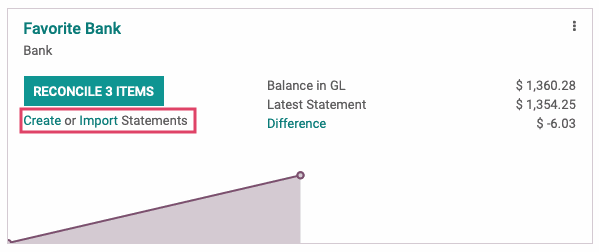
If your account is set to sync automatically, then depending on your synchronization frequency, you may choose to sync again before getting started, so you'll have the most updated transactions
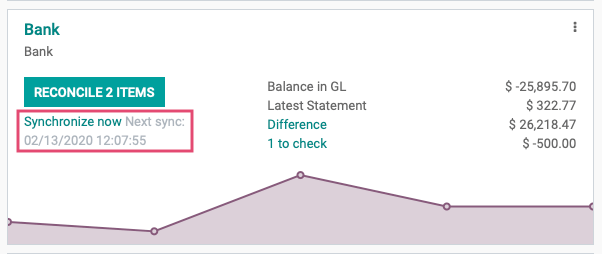
From the journal card, use the menu to navigate to Statements.
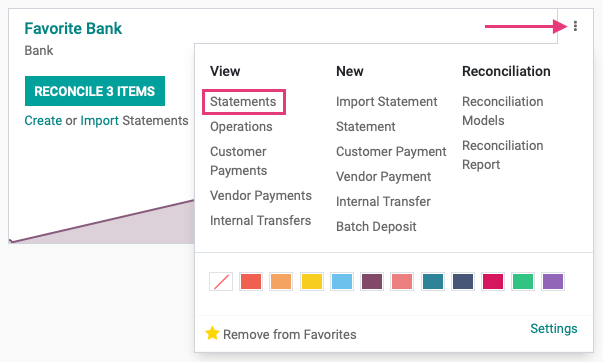
Once you're on the bank statement page, you'll see all of the bank statements that have been imported into Odoo either manually or through any automatic bank synchronization that you have set up. For more information on setting up your bank statements, please see the Setting up a Bank Account document.
Select the bank statement that you would like to reconcile.

On the statement, you'll see all of your bank transactions in a form view. Click the reconcile button to begin the reconciliation process.

Odoo Match Suggestions
On the reconciliation page, Odoo will make suggestions for transactions that match, and you can see this in how it's broken down into different sections, and how it gives the option to Validate the match.
The entries clearly have matching BILL and INV records, so it's easy to see that these transactions are paired correctly. The debit will show on the left, the credit on the right, and both column totals will match.
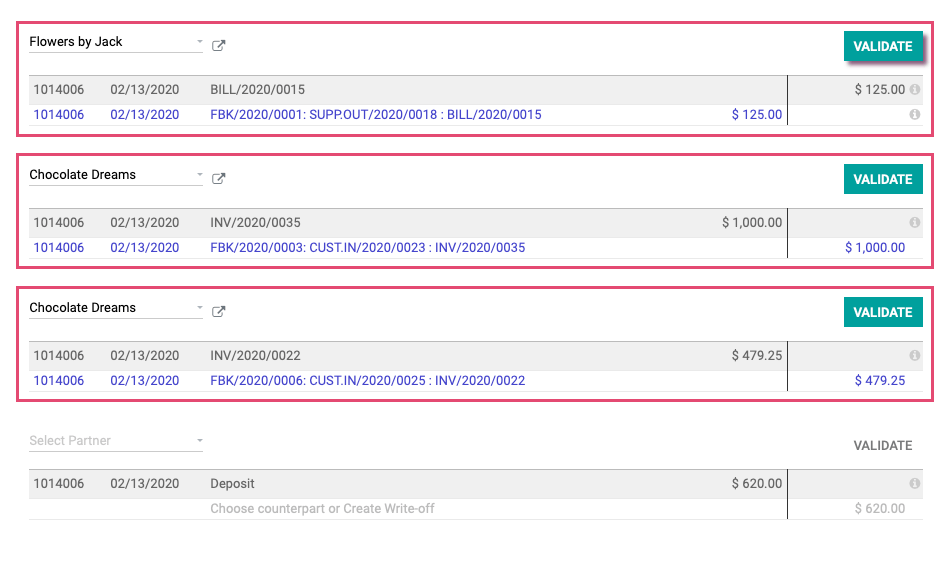
Something went wrong!
Sometimes during reconciliation, you'll get the following error.

If this happens, go back to the statement by clicking bank statements in the breadcrumbs.

Select the statement from the entries.

Under the Transactions tab, reverse reconciliation on ALL transactions you may have already reconciled by clicking the icon to the right of the amount . You'll need to click all instances of this icon.

Copy the date on this statement, then click Action > Duplicate.

This will bring you to the duplicated statement. Enter a Reference name so you can differentiate it from the original, then paste in the Date from the original statement.
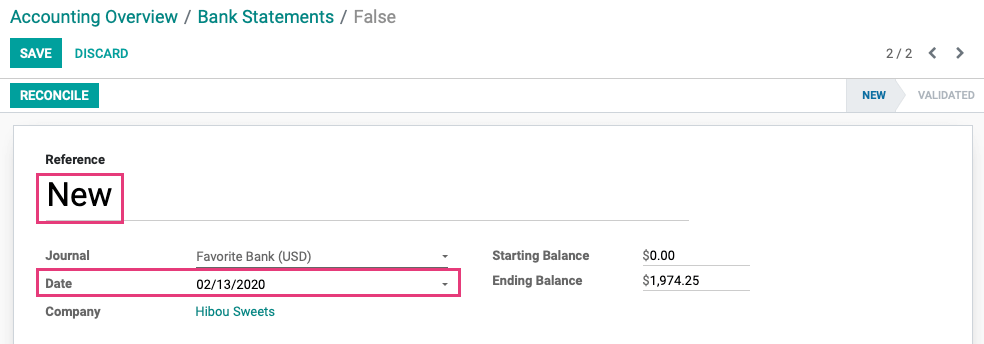
When done, click SAVE. Use the breadcrumbs to navigate back to Bank Statements.

Tick the box next to the original statement, then click Action > Delete.

Now, you should be able to reconcile with the new duplicated statement without error.
Reconciling by Payment Matching
You should always attempt to record a payment directly from the invoice, or record a vendor payment directly from the bill. This is how it works in a perfect world; however, there will be times when you'll have transactions entered independently of their counterparts. That's where Payment Matching comes in.
It's important to note that Payment Matching is unrelated to your bank statement reconciliation, and simply lets you link transactions together.
In our example, Terry from Jamz Jams came in with a check. He didn't know which invoice he was paying, he only knew he owed $257.50. We wanted to quickly get him a receipt, so we received the payment into Odoo while he waited, but didn't link it to an invoice because we were short on time.
From Customers > Payments, let's find the payment received from Terry.

From within this payment record, click the Payment Matching smart button.
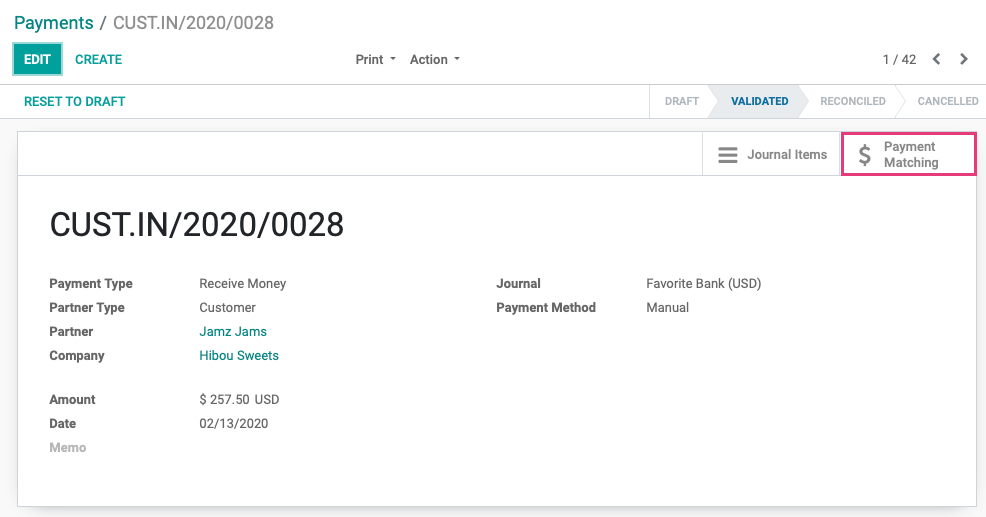
Good to Know!
What is a T Sheet?
We'll occasionally refer to a T Sheet when talking about reconciliation. A T sheet is a form used in double-entry accounting. As in the example shown, there's a "T" on the page with the account is listed on the top (whether asset or liability). Then, the debit entries are in the left column and the credit entries in the right column. The goal is for both columns to balance.
After clicking the Payment Matching button, all of the reconcilable lines for this partner are displayed, along with a blank T sheet.
Select the entries that match each other to add them to the T sheet.
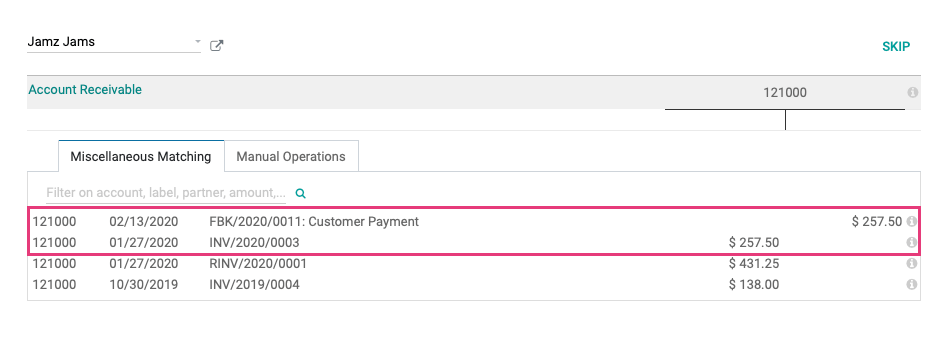
Click Reconcile when the columns are balanced and the correct transactions are matched.

Good to Know!
You can use a Reconciliation Model to manually reconcile bank statement lines to the correct account without needing to select it from the Accounts drop-down menu.
See our documentation on Reconciliation Models for more information and details.
Manually Matching Transactions
If there are lines that don't have a clear match during the Reconciliation process, you won't have the option to validate and there will be no suggested transactions. Instead, you'll need to add the balancing transactions manually.
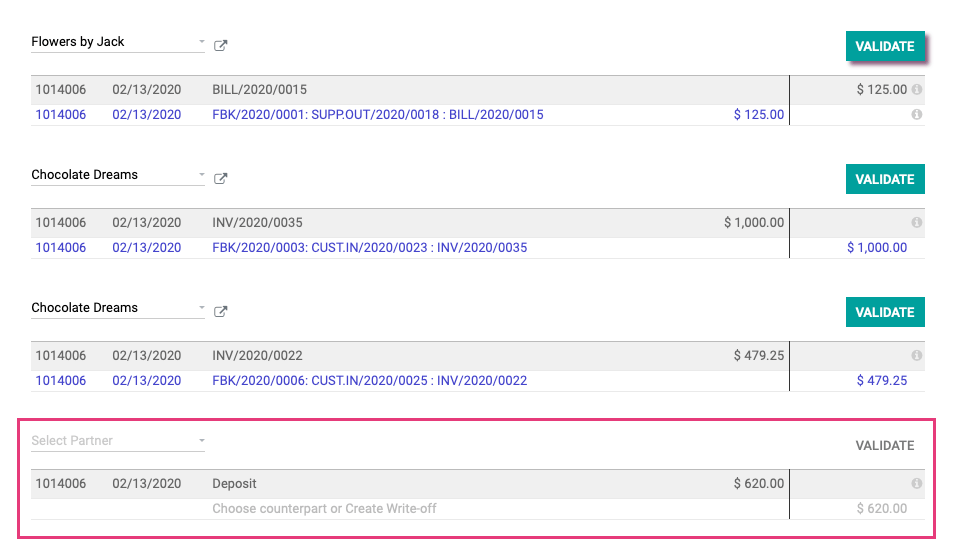
To do so, click the Choose counterpart or Create Write-off line. To the far right of this line, you'll also see the transaction total that we're looking for, listed in gray ($620.00). This means we need to find transaction(s) in blue that match that total.

Under the Customer/Vendor Matching tab, you'll see all possible transactions. This example emphasizes how important it is to include reference transaction numbers on your deposits. In this scenario, there are no single transactions that total $620.00, so we'll need to investigate to determine what to link.
Luckily we just entered these into the bank ledger, and we happen to know that this was one check paid by Andy Muffin for two different invoices. We can use the filter on this particular record to narrow it down.
Once we filter by partner (Andy Muffin) we can see that he has two transactions who's sum matches the total we're looking for. By clicking each of these individual entries, they'll move to the form above.

By clicking each of these individual entries, they'll move to the form above and allow me to validate.

Reconciling on Partial Payment
Not all payments on invoices and bills are for the full amount. Odoo makes it easy to do a partial reconciliation in these scenarios.
For our example, we have a vendor bill for $1000 from our partner, KwikShip, for packaging supplies and services. We've agreed to pay them $500 now and $500 next month. We've just registered our first payment in Odoo as a vendor payment, and also in our Favorite Bank journal, so it's reflected on our bank statement, too.
Now we can reconcile!
From Overview, click the menu on the Favorite Bank journal, then select Statements.
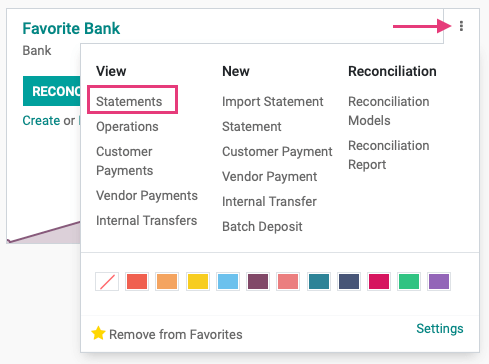
Then click the statement to reconcile.

Click Reconcile, then scroll down and find the first payment that we just recorded. We made a note on this deposit making it clear that it was from KwikShip, so let's use the Partner filter to bring up all KwikShip entries.

The two entries in black are both the bill for $1,000 and our first payment of $500. We'll click those entries to add them to the T Sheet.
The remaining entry is shown in blue, this is because Odoo thinks it's the most likely match for the amount in the credits column on the T Sheet. Odoo is right, so we'll click to add it to the sheet, as well.
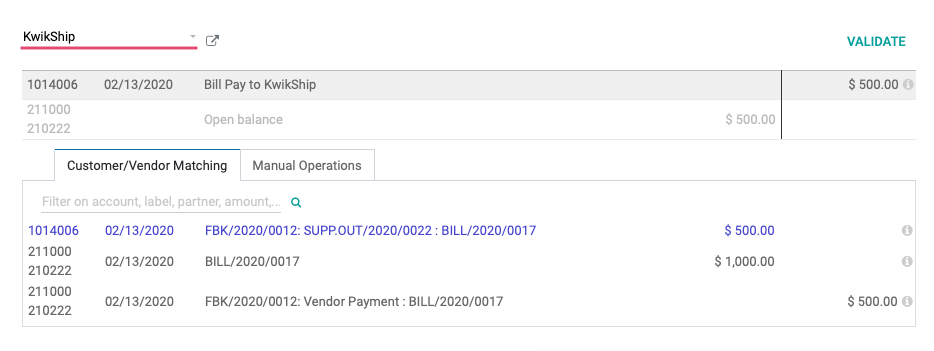
Remember, both columns must match in order to properly reconcile, so we need to modify the amount being paid. We do this by clicking the pencil icon next to the original amount due.

Once clicked, Odoo will match the actual amount from the credit column, and we'll validate the payment.

Important!
Using the pencil to edit the invoice amount being paid (debit) is critical in this scenario. If the debit and credit columns don't match, you'll end up marking the invoice paid in full and the balance due will be written off.
Now navigate to Vendors > bills, and open the bill we just applied this payment to.

In the totals area, you can see that we still owe $500 and the payment was applied. Click the information icon to see details to the payment made, as well as the option to view or unreconcile.
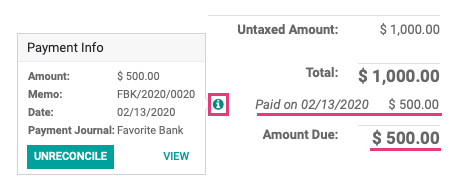
Good to Know!
Settling an Invoice on Partial Payment
There may be times when a partial payment will be sufficient to settle an invoice. This may be based on things like specific payment terms, or a verbal agreement. It's important to first understand Reconciliation Models. Creating a "Write-Off" model will provide a button under the Manual Operations tab allowing you to quickly write off the balance of an invoice and maintain control over where those funds are recorded.
In this example, we've agreed to take $50 off of the customer's total if they pay on the day of their order. From their payment record, we opened Payment Matching and added the total due ($639) and the payment ($589) to the T Sheet.
For the remaining balance ($50), we'll click Write Off.
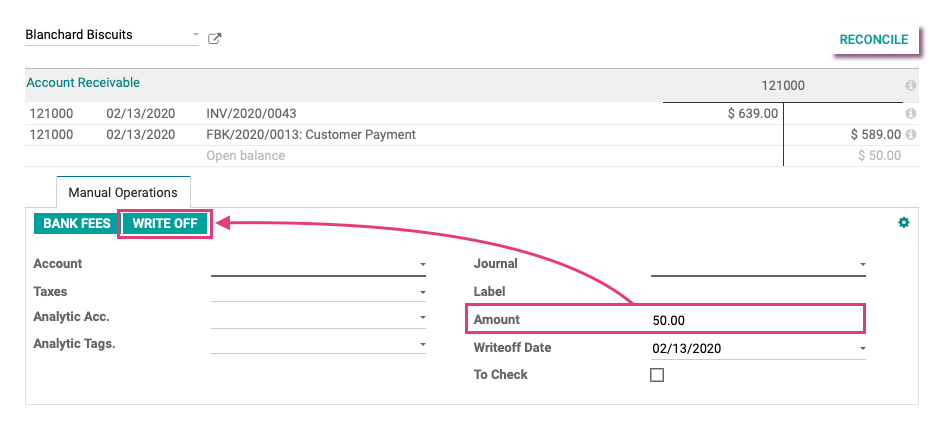
This will populate the appropriate fields with the settings from the Write Off Reconciliation Model, and add the $50 offset to the T Sheet. We can then click Reconcile.

The original invoice now shows as paid in full.
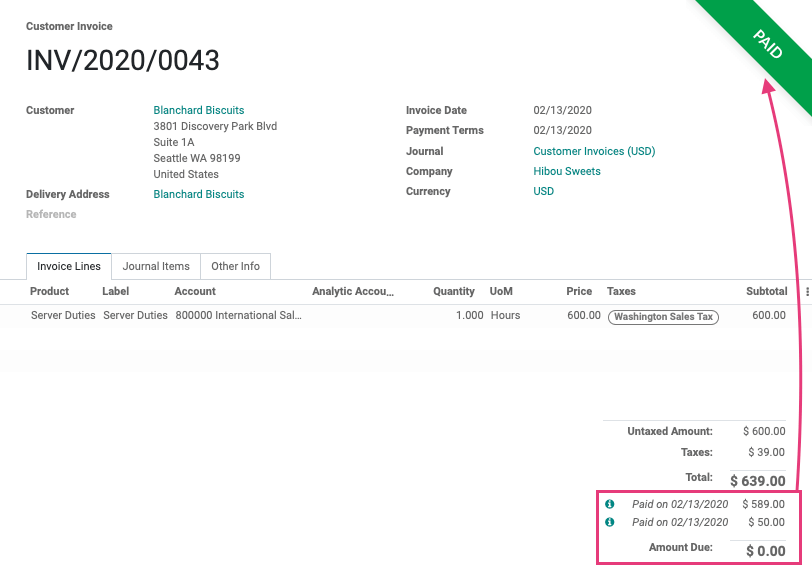
Reconciliation on Overpayment
An overpayment happens when the customer pays you more than they owe.
For our example, our customer Mae Berry Daycare has an invoice due, and she knows it's under $300, but not the exact amount. To be on the safe side, she decided to send us a payment for $300. We registered this payment in Odoo as a customer payment and as a bank deposit to Favorite Bank, so it will reflect in our bank statement as well.
From OVERVIEW, click the menu on the Favorite Bank journal, then select Statements.

Then click the statement to reconcile.

Click RECONCILE, then scroll down and find the payment entered for Mae Berry Daycare. Since the current entries balance each other out already, we can simply click the line in blue to remove it and show us all entries needing reconciliation for this partner.

First, add the two entries in black. These represent the payment due ($243.75) and the payment made ($300).
The last entry is shown in blue is one that Odoo thinks it's the most likely match for the deposit amount in the debit column on the T Sheet. Odoo is right, so we'll add it to the sheet, as well.

Now, we'll click validate to reconcile these entries to each other.

This invoice is now paid, and our customer will have a $56.25 credit that can be applied to a future invoice.
Reconciling Multiple Lines
Odoo makes it very easy to reconcile multiple transactions to one invoice or vendor bill.
For this example, our customer Chocolate Dreams has three employees who are pitching in to pay for 300 cupcakes for an upcoming event. Their total due is $750. They've given us three separate checks, which we've added as customer payments, but not directly from the invoice.
To link these transactions together, we'll go to Customers > payments and open one of the payments we just recorded.

From within this payment, we'll click the Payment Matching smart button.
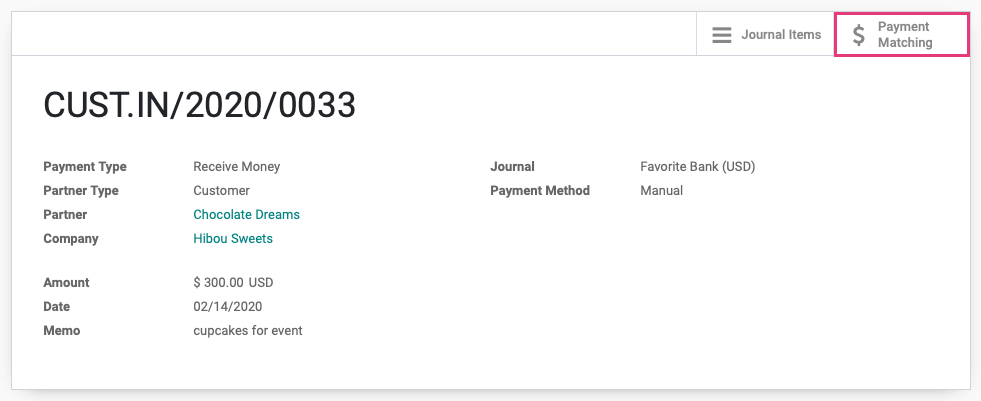
Now we'll add the original invoice and the three payments to the T Sheet.

Once both columns balance, we'll click Reconcile.
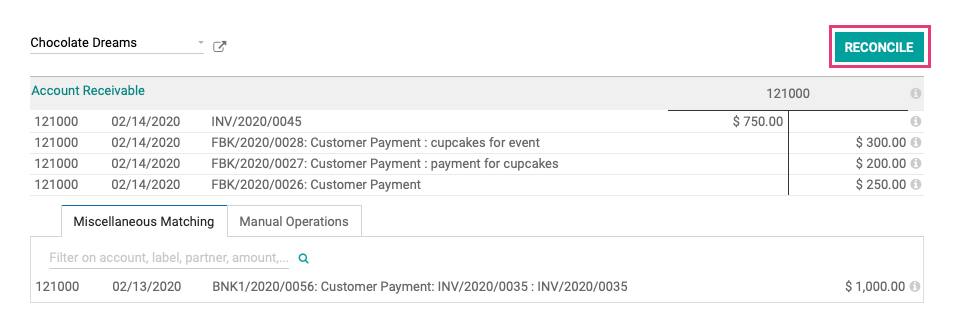
Canceling Reconciled Payments
From the Bank Statement
To reverse reconciliation on any reconciled bank statement line, click the icon next to the amount. This will set the transaction to unreconciled and allow you to re-reconcile that line to the appropriate no journal item.
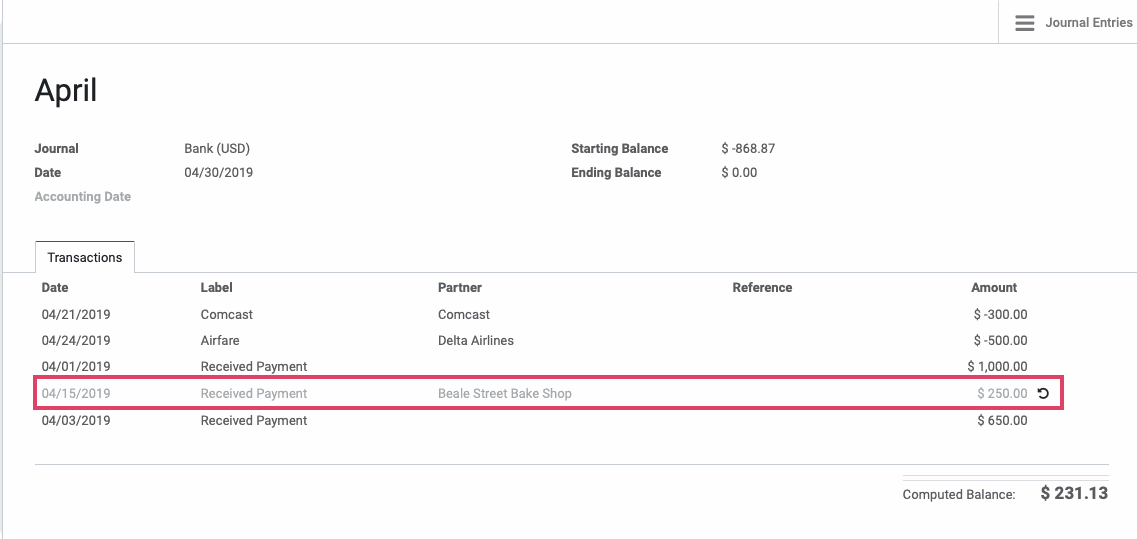
From a Paid Invoice
Open the paid invoice from Customers > Invoices, then scroll to the totals area. Click the information icon and you'll have the option to unreconcile.
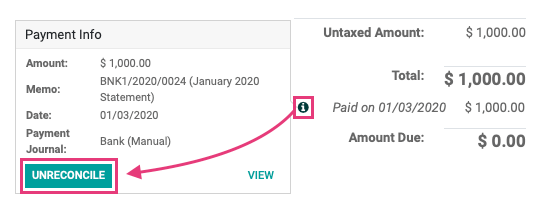
From the Payment Journal Items
Open a reconciled payment through Customers > Payments. Once there, click the Journal Items smart button.

This will show you all of the journal items associated with that payment. Tick the checkbox next to the journal items to unreconcile, then click Action > Unreconcile Entries.

